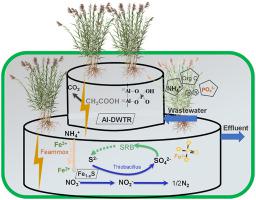Journal of Cleaner Production ( IF 11.1 ) Pub Date : 2021-01-25 , DOI: 10.1016/j.jclepro.2021.126087 Yan Yang , Yaqian Zhao , Cheng Tang , Yi Mao , Tianhu Chen , Yuansheng Hu

|
Integrated constructed wetland-microbial fuel cells (CW-MFCs) use exoelectrogenic bacteria to transform the energy inherently existed in wastewater into bioelectricity and simultaneously remove the contaminants in wastewater. They have the potential to provide a solution for both water and energy challenges. In this study, a novel two-tiered CW-MFC system consisted of a dewatered Al-DWTR-based up-flow CW-MFC (Top CW-MFC) and a pyrrhotite-based downflow CW-MFC (Bottom CW-MFC) was constructed. The two-tiered CW-MFC system was operated under different COD concentrations, HRTs and operation modes over a 477-day trial. The treated effluent had an overall average COD concentration of 69.05 mg/L. High power density of the top CW-MFC of 741.36 mW/m3 (A1-C) and 339.56 mW/m3 (A2-C) at HRT of 2.49 d (Phase 7) with continuous flow and 1162.63 mW/m3 (A1-C) and 352.34 mW/m3 (A2-C) with tidal flow (Phase 10), respectively, was achieved. Co-occurrence of Feammox and iron sulphide-based denitrification were found in bottom CW-MFC, leading to the enhanced nitrogen removal in the system. The genera of SRB (Desulfosporosinus, Desulfobulbus, Desulfobacca, Desulfovibrio and members of Desulfobacteraceae), exoelectrogenic bacteria enriched in the system resulted in a low release of sulfate, and effective pollutant removal and bioelectricity production. The findings highlight the novel two-tiered CW-MFC system for efficient wastewater treatment and high performance of energy extraction, supporting a clean environment.
中文翻译:

两层构造的湿地微生物燃料电池中新型的黄铁矿和明矾污泥为底物
集成构造的湿地微生物燃料电池(CW-MFC)使用外生电细菌将废水中固有的能量转换为生物电,并同时去除废水中的污染物。他们有潜力为水和能源挑战提供解决方案。在这项研究中,一种新颖的两层CW-MFC系统由脱水的基于Al-DWTR的上流CW-MFC(顶部CW-MFC)和基于黄铁矿的下流CW-MFC(底部CW-MFC)组成。建造。在477天的试用期内,两层CW-MFC系统在不同的COD浓度,HRT和运行模式下运行。处理后的废水的总平均COD浓度为69.05 mg / L。顶部CW-MFC的高功率密度为741.36 mW / m 3(A1-C)和339.56 mW / m 3连续流动的HRT为2.49 d(第7阶段)(A2-C),潮汐流动(第10阶段)分别为1162.63 mW / m 3(A1-C)和352.34 mW / m 3(A2-C)。实现。在底部CW-MFC中发现同时存在Feammox和基于硫化铁的反硝化作用,从而提高了系统中的氮去除率。SRB属(Desulfosporosinus,Desulfobulbus,Desulfobacca,Desulfovibrio和Desulfobacteraceae的属)。),系统中富集的放生电细菌导致硫酸盐释放量低,有效去除污染物和产生生物电。研究结果突出了新颖的两层CW-MFC系统,该系统可进行有效的废水处理和高性能的能量提取,支持清洁的环境。



























 京公网安备 11010802027423号
京公网安备 11010802027423号